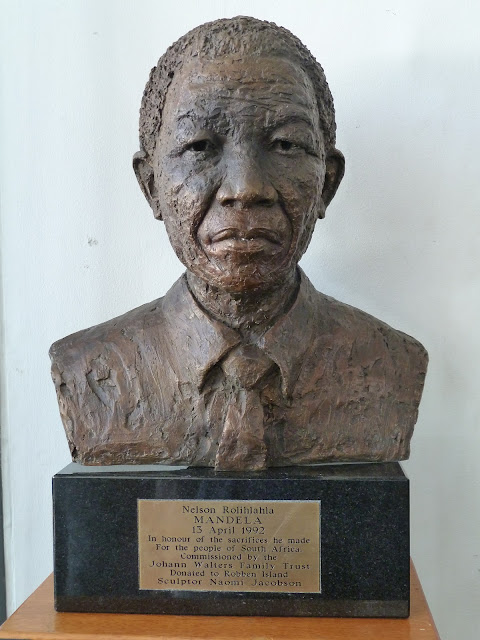There's a great deal to be added below, in order to make more sense of the images, but [as I write] time is ticking and the text will have to wait for more detailed editing.
From the 17th to the 20th centuries, Robben Island served as a place of banishment, isolation and imprisonment. Today it is a World Heritage Site and museum, a poignant reminder to the newly democratic South Africa of the price paid for freedom.
Chronology
Pre 1498: Pre-colonial
Unknown
- Archaeological research being conducted.
1498-1652: European ships passing the Island via the Cape to the East
Prison, refuge, pantry and post office
- 1498: First recorded landing on RI by Vasco da Gama's fleet.
- c.1525: Portuguese convicts
- 1615: English convicts
- 1632-40: Autshumato living on RI
1652-1795: Dutch East India Company period
Prison, Pantry & Quarantine station
- c.1658- 1795: Criminal and political prisoners
- 1682 - 1795: East Asian exiles
- 1771-1790: Quarantine station
1795-1802: First British occupation
Prison
- Military & criminal prisoners
1803-1806: Batavian period
Prison
1806-1910: British colonial period
Prison & Hospital
- 1808-1846: Military, criminal and political prisoners
- 1846-1931: Hospital for lepers (until 1931), lunatics (until 1921) and chronic sick (until 1891)
- 1855-1869: Xhosa political prisoners
- 1874-1890: Prisoners from present-day Kwazulu Natal and Northern Cape regions
- 1866-1921: Convict station
1910-1961: Union of South Africa
Convict station, Hospital & Coastal Defence and Training Station
- 1866-1921: Convict station
- 1846-1931: Hospital for lepers (until 1931), and lunatics (until 1921).
- 1939-1959: Occupied by the Army and Navy for training and coastal defence
1961-1994: Apartheid Republic of South Africa
Prison
- 1961-1991: Maximum security prison for political prisoners
- 1961-1996: Medium security prison for criminal prisoners
1994: Democratic South Africa
Museum & Heritage Site
- 1997: Museum, National Monument
- 1999: World Heritage Site
Robben Island has not only been used as a prison. It was a training and defence station in World War II (1939-1945) and a hospital for people with leprosy, and the mentally and chronically ill (1846-1931). In the 1840s, Robben Island was chosen for a hospital because it was regarded as both secure (isolating dangerous cases) and healthy (providing a good environment for cure). During this time, political and common-law prisoners were still kept on the Island. As there was no cure and little effective treatment available for leprosy, mental illness and other chronic illnesses in the 1800s, Robben Island was a kind of prison for the hospital patients too.
A particular prisoner was in this small dwelling, and he died in captivity [though not on the island]. The other enclosures are whee the guard dogs were kept.
One stone laid by each returning ex-prisoner to mark the entrance to the quarry where they broke rocks by hand.
The view to the mainland.
All the guides are ex-prisoners who consider a duty to tell visitors about the real details of the regime they suffered whilst they were here.
This is the main courtyard of the maximum security block where Mandela was held. The bottom right hand corner was his 'garden'.
That's Mandela & Walter Sissulu on the right
Mandela's 'garden'.
Mandela's cell.










































No comments:
Post a Comment